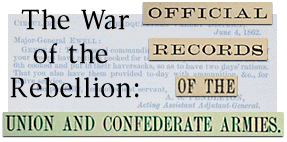Summary:
Col. H. P. Jones commanded the Artillery Battalion of the Army of Northern
Virginia which included the Staunton Artillery. Jones reports that the artillery
fired on the enemy in his works and on enemy re-enforcements.
[J. THOMPSON BROWN, Acting Chief of Artillery, Second Corps.]
March 31, 1864
COL:
I have the honor to make the following report of the operations of the artillery under my command in the battle of Chancellorsville:
The Napoleon guns of my battalion, except two of Tanner's battery, were sent very early in the morning of Sunday, May 2 [3], under the command of Capt. [James McD.] Carrington and Lieut. [Alexander H.] Fultz, commanding Staunton Artillery, to the right of the road about half a mile, and were for the time under the command of some other officer--Col. [T. H.] Carter, I think. Capt. [C.] Thompson, commanding Louisiana Guard Artillery, with a section of rifled guns, was placed near the road, under command of Maj. [D. G.] McIntosh. I was then ordered to take all the Napoleon guns unoccupied, and such other guns as would be of service, to a point farther down the road, and nearer to the enemy's breastworks. This I did, and placed the guns in position so as to have a front fire on their works and to enfilade the road. We immediately opened fire on the enemy, and succeeded in materially assisting to dislodge him from his works. During the action, a charge having been made on the works by the infantry, the fire of the guns was directed upon a dense column of the enemy coming down the road in front of the Chancellor house to re-enforce those who held their line of works. Enfilading this column as we did, we very soon broke it and dispersed the men. I afterward found out from prisoners that this was Meagher's brigade.
In the meantime the enemy succeeded in turning the flank of a portion of a brigade of ours on the left of the road, and compelled it to fall back into the road a short distance in front of our guns. From the manner in which our men retired, I supposed that the enemy were close and would soon be in the road. I therefore ordered such guns as were in the road to be loaded with canister, and to fire at the word. As soon as the enemy appeared in the road, the order was given to fire, and the enemy were driven back in confusion. The batteries were then ordered forward to take position behind the works of the enemy, but before the movement could be executed entirely, the enemy reoccupied them, and we were compelled to retire to our former position.
Although very much exposed, the casualties were inconsiderable, owing to the wild fire of the enemy, caused by the destructive fire of our guns on the right, under Lieut.-Col. Carter.
After continuing in this position for two hours, hotly engaged, and occasionally directing the fire of some of the guns on the enemy advancing through the woods on our left, we were relieved by Maj. McIntosh; not, however, until the enemy had been driven from the plateau in front of the Chancellor house.
The following batteries and portions of batteries were engaged, making in all twelve guns under my command: From Col. Carter's battalion, Capt. [William P.] Carter, commanding battery, Capt. [William J.] Reese, and Capt. [C. W.] Fry; Capt. [W. A.] Tanner, with a section of Napoleon guns of my own battalion, and Lieut. [O. B.] Taylor, commanding a section of guns from Eubank's battery, Alexander's battalion.
My thanks are due to the officers and men for the coolness and gallantry they displayed in this trying and exposed position.
I have to regret that I have not the material at hand for a fuller and more accurate report.
Very respectfully, your obedient servant,
H. P. JONES,
Col. of Artillery.
Bibliographic Information : Letter Reproduced from The War of The Rebellion: Official Records of the Union and Confederate Armies, , , Broadfoot Publishing Company, , .

